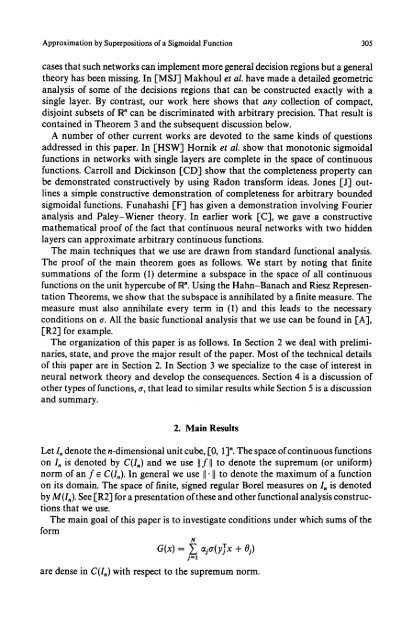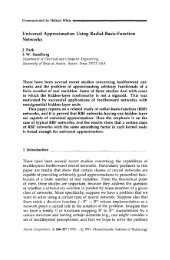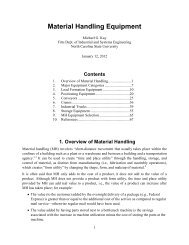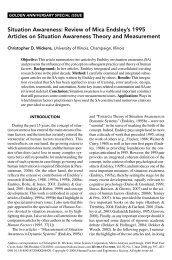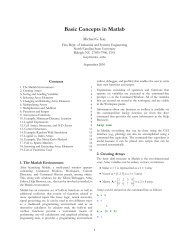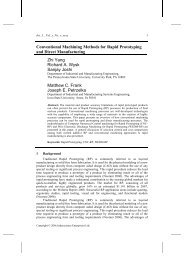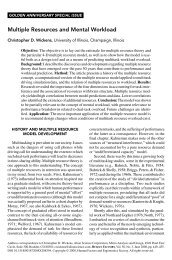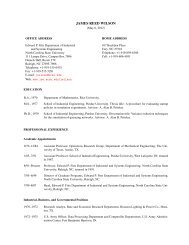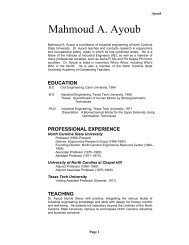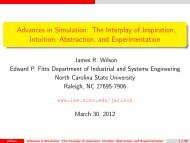Approximation by superpositions of a sigmoidal function
Approximation by superpositions of a sigmoidal function
Approximation by superpositions of a sigmoidal function
Create successful ePaper yourself
Turn your PDF publications into a flip-book with our unique Google optimized e-Paper software.
<strong>Approximation</strong> <strong>by</strong> Superpositions <strong>of</strong> a Sigmoidal Function 305<br />
cases that such networks can implement more general decision regions but a general<br />
theory has been missing. In [MS J-] Makhoul et al. have made a detailed geometric<br />
analysis <strong>of</strong> some <strong>of</strong> the decisions regions that can be constructed exactly with a<br />
single layer. By contrast, our work here shows that any collection <strong>of</strong> compact,<br />
disjoint subsets <strong>of</strong> R n can be discriminated with arbitrary precision. That result is<br />
contained in Theorem 3 and the subsequent discussion below.<br />
A number <strong>of</strong> other current works are devoted to the same kinds <strong>of</strong> questions<br />
addressed in this paper. In [HSW] Hornik et al. show that monotonic <strong>sigmoidal</strong><br />
<strong>function</strong>s in networks with single layers are complete in the space <strong>of</strong> continuous<br />
<strong>function</strong>s. Carroll and Dickinson [CD] show that the completeness property can<br />
be demonstrated constructively <strong>by</strong> using Radon transform ideas. Jones [J] outlines<br />
a simple constructive demonstration <strong>of</strong> completeness for arbitrary bounded<br />
<strong>sigmoidal</strong> <strong>function</strong>s. Funahashi [F] has given a demonstration involving Fourier<br />
analysis and Paley-Wiener theory. In earlier work [C], we gave a constructive<br />
mathematical pro<strong>of</strong> <strong>of</strong> the fact that continuous neural networks with two hidden<br />
layers can approximate arbitrary continuous <strong>function</strong>s.<br />
The main techniques that we use are drawn from standard <strong>function</strong>al analysis.<br />
The pro<strong>of</strong> <strong>of</strong> the main theorem goes as follows. We start <strong>by</strong> noting that finite<br />
summations <strong>of</strong> the form (1) determine a subspace in the space <strong>of</strong> all continuous<br />
<strong>function</strong>s on the unit hypercube <strong>of</strong> R n. Using the Hahn-Banach and Riesz Representation<br />
Theorems, we show that the subspace is annihilated <strong>by</strong> a finite measure. The<br />
measure must also annihilate every term in (1) and this leads to the necessary<br />
conditions on ~r. All the basic <strong>function</strong>al analysis that we use can be found in [A],<br />
[R2-1 for example.<br />
The organization <strong>of</strong> this paper is as follows. In Section 2 we deal with preliminaries,<br />
state, and prove the major result <strong>of</strong> the paper. Most <strong>of</strong> the technical details<br />
<strong>of</strong> this paper are in Section 2. In Section 3 we specialize to the case <strong>of</strong> interest in<br />
neural network theory and develop the consequences. Section 4 is a discussion <strong>of</strong><br />
other types <strong>of</strong> <strong>function</strong>s, tr, that lead to similar results while Section 5 is a discussion<br />
and summary.<br />
2. Main Results<br />
Let In denote the n-dimensional unit cube, [0, 1] n. The space <strong>of</strong> continuous <strong>function</strong>s<br />
on In is denoted <strong>by</strong> C(ln) and we use Ilfll to denote the supremum (or uniform)<br />
norm <strong>of</strong> an f ~ C(ln). In general we use I1"11 to denote the maximum <strong>of</strong> a <strong>function</strong><br />
on its domain. The space <strong>of</strong> finite, signed regular Borel measures on In is denoted<br />
<strong>by</strong> M(ln). See JR2] for a presentation <strong>of</strong> these and other <strong>function</strong>al analysis constructions<br />
that we use.<br />
The main goal <strong>of</strong> this paper is to investigate conditions under which sums <strong>of</strong> the<br />
form<br />
N<br />
G(x) = ~ ct~a(yTx + 0 r)<br />
j=l<br />
are dense in C(ln) with respect to the supremum norm.


